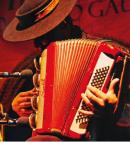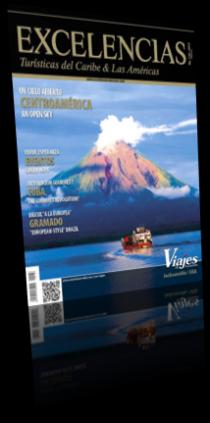- "European-style" Brazil.
Can you imagine Las Vegas without gambling and cigars? How about a two-month-long Christmas? And gardens carpeted with flowers all year round, with impeccable avenues where both pedestrians and cars circulate in harmony?
It can be imagined and it actually exists. Gramado is a city of 34 000 inhabitants, nestled in Sierra Gaucha, in Brazil's southernmost state of Rio Grande do Sul. This place could be labeled as a slow-life burg, which refers to that European vocation for the so-called “slow cities”. Gramado undoubtedly represents an exotic enclave that challenges the classic image used to characterize that South American nation.
On their first visit, travelers feel like they have arrived in some Central European city due to the peculiar architecture of alpine houses —including hotels and restaurants. The second thought is that they might have woken up in a stone-and-cardboard theme park. Gramado is both things. It’s also kind of kitsch in terms of overelaborate decorative elements, but all in all it’s very likable… as long as we follow "the game", because Gramado’s game is good life! High-quality services, elegant streets and stores, excellence of gastronomic offers and road safety; components required to have a great vacation.
Gramado’s economy is focused on the travel industry, so let’s just point out that it features over 100 restaurants large enough to seat 10 000 patrons at the same time. But it was not always like this. Its history dates back to the early 19th century with the arrival of the first settlers to that mountainous region characterized by rocky cliffs, rivers, waterfalls and thick vegetation. It’s a piece of natural scenery that can still be enjoyed by visitors from the belvedere at Knorr Park, especially when gazing at the Quilombo Valley.
The first Portuguese settlers were joined by Germans and Italians. That was the origin of a historic heritage that remains proudly alive and can be felt in customs, gastronomy and the peculiar urban architecture.
Although the mountains of Sierra Gaucha are not higher than a thousand meters, in winter (June to August) snow falls on the houses, so they look like Swiss chalets, with white roofs in contrast and vivid red of shutters. This weather —so different from the rest of the country— makes many Brazilians from other regions visit Gramado for a chance to see the snowy landscape. In summertime (November to January) thousands of hydrangeas flourish all over the place and they stand for the symbol of the city. That’s when Christmas is celebrated —not any Christmas— and that’s the high-peak season for the local travel industry.
Emotional Tourism
I know that I’m talking about Brazil, but Gramado doesn’t have beach volleyball, carnivals, or samba. It hosts another kind of tourism events, such as Chocofest chocolate fair, a prestigious Movie Festival (www.festivaldegramado.com.br), and its well-positioned Tourism Fair FESTURIS (www.festivalturismogramado.com.br), one of the most important events of its kind in South America, which this year held its 27th edition.
Gramado also features several theme parks aimed at family tourism, such as the Mini World, a group of miniature replicas of typical houses, castles, cathedrals, mills and railroads; Black Lake, a delightful spot with lots of fun and entertainment, surrounded by natural environment; and Snowland (www.snowlandgramado.com.br), a “below-zero” leisure facility where you can ski all year long. I can’t miss out on Santa Claus Village (www.papainoel.com), a magical kingdom for children and adults with true reindeers during Christmas.
Moreover, Gramado holds an annual event that gathers nearly two million visitors, called Natal Luz (www.natalluzdegramadocom.br), the longest-lasting Christmas on earth, stretching out from November 1 to January 12, when the city radiates joy and gets highly decorated. Throughout these 73 days, parades and theater displays take place almost on a daily basis. Natal Luz is the greatest Christmas show in Brazil. A team made up of 500 people (technicians, actors and artists) reproduces and plays the arrival of Jesus Christ to this "valley of tears". An army of floats, acrobats, dancers, skaters, lights and sound, snow cannons, laser rays and fireworks, totaling one million reals (over $350,000), a well-invested figure that always generates benefits, with tickets ranging between 15 and 70 dollars apiece.
Three different shows are displayed every year, in different locations and colossal makeshift stages: "The Fantastic Christmas Factory", a journey to the imagination of a boy that is taken by an angel into a fantasy world, recreated in a huge set with toys; "Nativitaten", an outdoor opera show starred by several tenors, who stand on platforms anchored at Rita Bier Lake, surrounded by laser sparkles, blazes and spectacular fireworks; and the "Grand Christmas Parade", a show described as the outmost Christmas event in Brazil, which takes place along Hydrangeas Avenue, with floats related to the five continents, giant tin soldiers and the exoticism of the Eastern Magi. The parade comes to a close with the performance of the Santa Claus troupe, with emotional moments, featuring elderly men with long white beards coming from different regions of the country. One Santa Claus per each child! That’s touching.
Gramado was the land promised to the Europeans and it presently stands as a “European-style” city. It’s synonymous of peace and tranquility, away from the exhausting frenetic pace of the big city life, where airs of good life can truly be breathed in.



























































































































